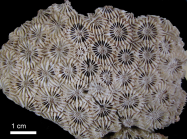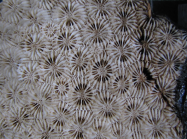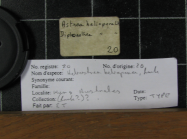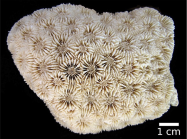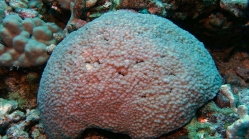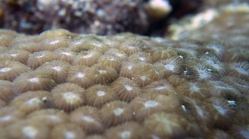WoRMS taxon details
Diploastrea Matthai, 1914
204221 (urn:lsid:marinespecies.org:taxname:204221)
accepted
Genus
Orbicella minikoiensis Gardiner, 1904 accepted as Diploastrea heliopora (Lamarck, 1816) (type by original designation)
Diploastraea Matthai, 1914 · unaccepted > misspelling - incorrect subsequent spelling
Thegioastraea Sismonda, 1871 † · unaccepted > junior subjective synonym
- Species Diploastrea aeqalis Budd, 1992 †
- Species Diploastrea aequalicostata (Osasco, 1897) †
- Species Diploastrea applanata Gerth, 1925 †
- Species Diploastrea bacata Budd, 1992 †
- Species Diploastrea crassolamellata (Duncan, 1863) †
- Species Diploastrea diversiformis (Michelin, 1842) †
- Species Diploastrea harrisi Wells, 1932 †
- Species Diploastrea heliopora (Lamarck, 1816)
- Species Diploastrea hilli Wells, 1933 †
- Species Diploastrea magnifica (Duncan, 1863) †
- Species Diploastrea polygonalis (Martin, 1880) †
- Species Diploastrea taurinensis (d'Achiardi, 1868) †
- Species Diploastrea glaucopsis (Dana, 1846) accepted as Diploastrea heliopora (Lamarck, 1816) (unaccepted > junior subjective synonym)
- Species Diploastrea patula (Dana, 1846) accepted as Diploastrea heliopora (Lamarck, 1816) (unaccepted > junior subjective synonym)
- Species Diploastrea vaughani Wells, 1933 † (uncertain > taxon inquirendum)
marine, fresh, terrestrial
Matthai G. (1914). A revision of the recent colonial Astraeidae possessing distinct corallites. <em>Transactions of the Linnean Society of London, 2nd Series Zoology.</em> 17(1): 1-140, pls. 1-38. [details]
Description 'Corallum. Incrusting or massive. Corallites circular not projecting. Walls fused and perforate, hence peritheca almost...
Description Colonies dome shaped with an even surface. The skeleton is very dense. Corallites are plocoid. Columellae are large. Septa...
Description 'Corallum. Incrusting or massive. Corallites circular not projecting. Walls fused and perforate, hence peritheca almost absent. Calices shallow. Septa in not less than two orders, the first two entocoelic, each consisting of twelve septa, exsert, much thickened towards their outer ends. Columella formed of twisted trabeculæ from septal margins. Calicular dissepiments oblique. Polyps. Close together with narrow edge-zones, no coenosarc. Mesenteries in not less than two cycles, each of twelve couples, usually directly continuous from polyp to polyp, primaries meeting stomodæum; all with filaments. Mesoglæa thick. Tentacles corresponding in number and position with entocoeles and exocoeles. Stomodæum short, laterally compressed with two directive grooves. Multiplication by budding.' (Matthai, 1914: 72) [details]
Description Colonies dome shaped with an even surface. The skeleton is very dense. Corallites are plocoid. Columellae are large. Septa...
Description Colonies dome shaped with an even surface. The skeleton is very dense. Corallites are plocoid. Columellae are large. Septa are equal and are thick at the wall and thin where they join the columellae. Polyps are extended only at night (Veron, 1986 <57>). [details]
Hoeksema, B. W.; Cairns, S. (2024). World List of Scleractinia. Diploastrea Matthai, 1914. Accessed through: World Register of Marine Species at: https://www.marinespecies.org/aphia.php?p=taxdetails&id=204221 on 2024-11-21
Date
action
by
![]() The webpage text is licensed under a Creative Commons Attribution 4.0 License
The webpage text is licensed under a Creative Commons Attribution 4.0 License
original description
Matthai G. (1914). A revision of the recent colonial Astraeidae possessing distinct corallites. <em>Transactions of the Linnean Society of London, 2nd Series Zoology.</em> 17(1): 1-140, pls. 1-38. [details]
original description (of Thegioastraea Sismonda, 1871 †) Sismonda, E.; Michelotti, G. (1871). Matériaux pour servir à la paléontologie du terrain tertiaire du Piémont. <em>Memorie della Reale accademia delle scienze di Torino.</em> 2(25): 257-361., available online at https://www.biodiversitylibrary.org/page/36389689 [details]
context source (Hexacorallia) Fautin, Daphne G. (2013). Hexacorallians of the World. (look up in IMIS) [details]
basis of record Budd AF, Fukami H, Smith ND, Knowlton N. (2012). Taxonomic classification of the reef coral family Mussidae (Cnidaria: Anthozoa: Scleractinia). <em>Zoological Journal of the Linnean Society.</em> 166 (3): 465-529., available online at https://doi.org/10.1111/j.1096-3642.2012.00855.x [details]
additional source Veron JEN. (2000). Corals of the World. Vol. 1–3. <em>Australian Institute of Marine Science and CRR, Queensland, Australia.</em> [details]
additional source Wijsman-Best M (1977) Indo-Pacific coral species belonging to the subfamily Montastreinae Vaughan and Wells, 1943 (Scleractinia-Coelenterata) Part I. The genera Montastrea and Plesiastrea. Zoologische Mededelingen, Leiden 52: 81-97.
page(s): 84 [details]
additional source Huang D, Benzoni F, Fukami H, Knowlton N, Smith ND, Budd AF (2014) Taxonomic classification of the reef coral families Merulinidae, Montastraeidae, and Diploastraeidae (Cnidaria: Anthozoa: Scleractinia). Zoological Journal of the Linnean Society 171: 277–355. [details]
additional source Smith FGW. (1954). Gulf of Mexico Madreporaria. <em>Fisheries Bulletin of the Fish and Wildlife Service (U.S.).</em> 55, 291-295.
page(s): 294 [details]
original description (of Thegioastraea Sismonda, 1871 †) Sismonda, E.; Michelotti, G. (1871). Matériaux pour servir à la paléontologie du terrain tertiaire du Piémont. <em>Memorie della Reale accademia delle scienze di Torino.</em> 2(25): 257-361., available online at https://www.biodiversitylibrary.org/page/36389689 [details]
context source (Hexacorallia) Fautin, Daphne G. (2013). Hexacorallians of the World. (look up in IMIS) [details]
basis of record Budd AF, Fukami H, Smith ND, Knowlton N. (2012). Taxonomic classification of the reef coral family Mussidae (Cnidaria: Anthozoa: Scleractinia). <em>Zoological Journal of the Linnean Society.</em> 166 (3): 465-529., available online at https://doi.org/10.1111/j.1096-3642.2012.00855.x [details]
additional source Veron JEN. (2000). Corals of the World. Vol. 1–3. <em>Australian Institute of Marine Science and CRR, Queensland, Australia.</em> [details]
additional source Wijsman-Best M (1977) Indo-Pacific coral species belonging to the subfamily Montastreinae Vaughan and Wells, 1943 (Scleractinia-Coelenterata) Part I. The genera Montastrea and Plesiastrea. Zoologische Mededelingen, Leiden 52: 81-97.
page(s): 84 [details]
additional source Huang D, Benzoni F, Fukami H, Knowlton N, Smith ND, Budd AF (2014) Taxonomic classification of the reef coral families Merulinidae, Montastraeidae, and Diploastraeidae (Cnidaria: Anthozoa: Scleractinia). Zoological Journal of the Linnean Society 171: 277–355. [details]
additional source Smith FGW. (1954). Gulf of Mexico Madreporaria. <em>Fisheries Bulletin of the Fish and Wildlife Service (U.S.).</em> 55, 291-295.
page(s): 294 [details]
 Present
Present  Inaccurate
Inaccurate  Introduced: alien
Introduced: alien  Containing type locality
Containing type locality
From editor or global species database
Comparison Diploastrea is easily distinguished from all of Montastraeidae, Merulinidae, Lobophylliidae and Mussidae by its synapticulotheca, presumably an autapomorphy. Examination of the microstructure of clade XIV would enable this hypothesis to be tested. In constrast to the other genera of Faviidae (sensu Veron, 2000), and Merulinidae in general, Diploastrea is differentiated on the basis of septal teeth that have elliptical-parallel bases and regular (pointed) tips, synapticulotheca, thickening deposits showing concentric rings with extensive stereome, costa and septum center clusters that are spaced far apart (> 0.6 mm and > 0.5 mm respectively), and absence of medial lines. Across its range, Diploastrea is easily recognizable and shows very limited variation (Crossland, 1952; Veron et al., 1977; Wijsman-Best, 1980; Wood, 1983; Veron, 1986, 2000). [details]Description 'Corallum. Incrusting or massive. Corallites circular not projecting. Walls fused and perforate, hence peritheca almost absent. Calices shallow. Septa in not less than two orders, the first two entocoelic, each consisting of twelve septa, exsert, much thickened towards their outer ends. Columella formed of twisted trabeculæ from septal margins. Calicular dissepiments oblique. Polyps. Close together with narrow edge-zones, no coenosarc. Mesenteries in not less than two cycles, each of twelve couples, usually directly continuous from polyp to polyp, primaries meeting stomodæum; all with filaments. Mesoglæa thick. Tentacles corresponding in number and position with entocoeles and exocoeles. Stomodæum short, laterally compressed with two directive grooves. Multiplication by budding.' (Matthai, 1914: 72) [details]
Diagnosis Colonial, with extracalicular budding only. Corallites monomorphic and discrete (1–3 centers); monticules absent. Coenosteum costate, moderate amount (< corallite diameter). Calice width medium (4–15 mm), with medium relief (3–6 mm). Costosepta not confluent. Septa in ≥ 4 cycles (≥ 48 septa; including very short free septa). Free septa present but irregular. Septa spaced 6–11 septa per 5 mm. Costosepta unequal in relative thickness. Columellae trabecular and spongy (> 3 threads), ≥ 1/4 of calice width. Paliform (uniaxial) lobes absent. Epitheca well developed and endotheca low-moderate (tabular). Tooth base at mid-calice elliptical-parallel. Tooth tip at mid-calice regular (pointed). Tooth height medium (0.3–0.6 mm) and tooth spacing medium (0.3–1 mm), with > 6 teeth per septum. Granules scattered on septal face; weak (rounded). Interarea smooth. Walls formed by synapticulotheca and partial septotheca; abortive septa absent. Thickening deposits in concentric rings with extensive stereome. Costa center clusters strong; > 0.6 mm between clusters; medial lines absent. Septum center clusters strong; > 0.5 mm between clusters; medial lines absent. Transverse crosses absent. Columella centers clustered. [details]
Remark Matthai, 1914: 72 explicitly states that Diploastrea was established based on Orbicella minikoiensis Gardiner, 1904: 774, pl. 63: fig. 35, which therefore is the type species. This species was shown to be the same as Astrea heliopora Lamarck, 1816: 265 (Matthai, 1914), commonly mistaken as the type of Diploastrea (Vaughan, 1918: 142; Vaughan, 1919: 469; Vaughan and Wells, 1943: 137; Wells, 1956: F405; Veron et al., 1977: 153; Veron, 1986: 512; Budd et al., 2012; but see Chevalier, 1975: 60; Chevalier and Beauvais, 1987: 721), but the genus description is clearly based on three specimens collected by Gardiner at Minicoy, Lakshadweep, India (i.e. type locality of Diploastrea). Although Diploastrea is a monotypic genus for living corals, at least 11 fossil species have been assigned to it—e.g. Diploastrea crassolamellata (Duncan, 1863: 413, pl. 13: figs 1a–c) by Coryell and Ohlsen, 1929: 216, pl. 39: fig. 2; D. harrisi Wells, 1932: 248, pl. 30: fig. 9, pl. 37: fig. 6, pl. 38: figs 5, 6; and D. aequalis Budd in Budd, Stemann and Stewart, 1992: 589, fig. 9.6—extending its stratigraphic range to the Lower Cretaceous (Wells, 1956). The phylogenetic placement of D. heliopora as the deepest branching species of clades XV to XXI (Budd et al., 2012) appears consistent with these fossil assignments, but a detailed morphological analysis is necessary. A recent age estimate based on a time-calibrated relaxed molecular clock suggests that the lineage extends only up to ~70 mya (Huang and Roy, 2013), but this needs to be verified with more data given its disparity with fossil collections. Diploastrea heliopora is the only living species to have been assigned to the genus throughout its taxonomic history (Wijsman-Best, 1980), a testament to its phylogenetic uniqueness. Indeed, no other living taxon has been placed in the family Diploastraeidae, as proposed by Chevalier and Beauvais, 1987: 721. This scheme was however not accepted by Veron (2000), whose use of Faviidae from Wells (1956) dominated conventional taxonomy until Budd et al. (2012) recently revived Diploastraeidae to reflect the unequivocal support for D. heliopora as a distinct lineage (clade XV) among living species, either sister to Montastraea cavernosa (Huang et al., 2011; Arrigoni et al. 2012), or to Montastraeidae + Merulinidae + Lobophylliidae + Mussidae (Fukami et al., 2008). Diploastrea is widely distributed on reefs of the Indo-Pacific, and absent eastwards from Hawai'i. [details]
Unreviewed
Description Colonies dome shaped with an even surface. The skeleton is very dense. Corallites are plocoid. Columellae are large. Septa are equal and are thick at the wall and thin where they join the columellae. Polyps are extended only at night (Veron, 1986 <57>). [details]
